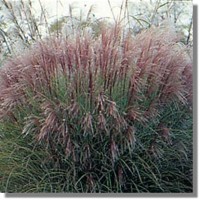 Tall ornamental grasses can be utilized as screens or hedges. Some can even be effective as windbreaks. They come in different heights, colors, and textures so can fit into a variety of landscapes where they will provide movement as well as beauty. In addition to their attractive foliage, they have showy flowers that appear late in the season and persist. Even after the foliage has turned brown in the fall, these grasses can provide winter interest.
Tall ornamental grasses can be utilized as screens or hedges. Some can even be effective as windbreaks. They come in different heights, colors, and textures so can fit into a variety of landscapes where they will provide movement as well as beauty. In addition to their attractive foliage, they have showy flowers that appear late in the season and persist. Even after the foliage has turned brown in the fall, these grasses can provide winter interest.
Here are five grasses that will do well as screens or hedges.
Big Bluestem (Andropogon gerardii)
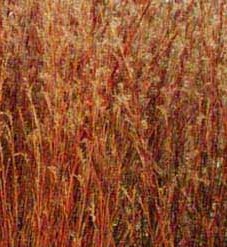 Growing six feet or more in height, this deciduous, clumping, warm-season grass was the primary grass of the tallgrass praires that once extended across mid-America. The foliage is various shades of blue-green to silvery blue, its flowers are purplish, and its seed heads are three branches, resembling a turkey foot. In fall the foliage takes on bronze tones that persists into winter. Desirable cultivars include “Champ’, ‘Kaw’, ‘Pawnee’, and ‘Roundtree’
Growing six feet or more in height, this deciduous, clumping, warm-season grass was the primary grass of the tallgrass praires that once extended across mid-America. The foliage is various shades of blue-green to silvery blue, its flowers are purplish, and its seed heads are three branches, resembling a turkey foot. In fall the foliage takes on bronze tones that persists into winter. Desirable cultivars include “Champ’, ‘Kaw’, ‘Pawnee’, and ‘Roundtree’
Height: 7-10’
Light: Full sun
Soil: Moist, well-drained
Hardiness: Zones 4-10
Giant Reed (Arundo donax)
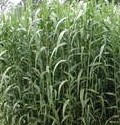 A native of southern Europe, giant reed is fast growing and tolerant of sun, heat, and drought. The blue green leaves are 18-24 inches long and 2-3 inches wide; its flowers are borne in fluffy panicles 19-30 inches long in September and persist into winter while the foliage turns beige. The upright canes are arching and were used for a variety of constructions needs by early settlers. Unfortunately, the plant can be invasive and is on the noxious week list in California and several southern states but colder climates it is a valuable landscape plant. Suitable for a windbreak. A variegated form is available and is a bit smaller in height..
A native of southern Europe, giant reed is fast growing and tolerant of sun, heat, and drought. The blue green leaves are 18-24 inches long and 2-3 inches wide; its flowers are borne in fluffy panicles 19-30 inches long in September and persist into winter while the foliage turns beige. The upright canes are arching and were used for a variety of constructions needs by early settlers. Unfortunately, the plant can be invasive and is on the noxious week list in California and several southern states but colder climates it is a valuable landscape plant. Suitable for a windbreak. A variegated form is available and is a bit smaller in height..
Height: 10-25’
Light: Full sun
Soil: Fertile, moist, well-drained
Hardiness: Zones
Ravenna Grass (Erianthus ravennae)
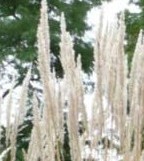 This clumping deciduous grass has medium gray-green leaves 3-4 feet long and ½ to 1 inch wide. The flowers are borne 8-10 feet above the foliage in August, turn fluffy and cream-colored as they mature, and persist into winter. In fall the leaves turn shades of orange, purple, brown, tan and beige. Excellent as a tall screen or windbreak.
This clumping deciduous grass has medium gray-green leaves 3-4 feet long and ½ to 1 inch wide. The flowers are borne 8-10 feet above the foliage in August, turn fluffy and cream-colored as they mature, and persist into winter. In fall the leaves turn shades of orange, purple, brown, tan and beige. Excellent as a tall screen or windbreak.
Height: 4-5’ (with flower spikes 8-10 feet taller)
Light: Full sun
Soil: Fertile, moist, well-drained
Hardiness: Zones 6-10
Japanese Silver Grass (Miscanthus sinesis)
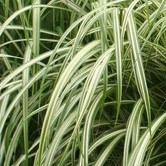 There are many good Miscanthus species but M. sinesis is the most popular and available. It is a clump-forming, warm-season, fine textured grass with attractive flowers and seed heads. The leaves are narrow and can be green, purple, or variegated with yellow or white depending on the cultivar. Suitable for hedge or screen. Outstanding varieities include ‘Cabaret’, ‘Gracillimus’, ‘Morning Night’, ‘Purpurascens, ‘Silberfeder’ and var. stritcus.
There are many good Miscanthus species but M. sinesis is the most popular and available. It is a clump-forming, warm-season, fine textured grass with attractive flowers and seed heads. The leaves are narrow and can be green, purple, or variegated with yellow or white depending on the cultivar. Suitable for hedge or screen. Outstanding varieities include ‘Cabaret’, ‘Gracillimus’, ‘Morning Night’, ‘Purpurascens, ‘Silberfeder’ and var. stritcus.
Height: 4-6’ depending on the cultivar
Light: Full sun
Soil: Moist, rich
Hardiness: Zones 6-10
Vetiver (Vetiver zizanioides)
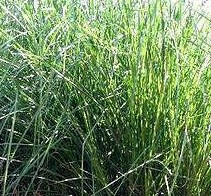 A native of India, Asia, and northern Africa, vetiver is a clumping, warm-season grass that is vigorous and and evergreen in mild climates. If forms a vertical clump and has glossy bronze-green leaves that turn over 1-2 feet from the tip and turn purple-red at the fold. Plants are evergreen in tropical climates but take on a reddish purple tint where temperatures dip into the 30s. The flowers emerge in late summer, are 12-18 inches long, and form fluffy plumes. Suitable for hedge, screen or windbreak.
A native of India, Asia, and northern Africa, vetiver is a clumping, warm-season grass that is vigorous and and evergreen in mild climates. If forms a vertical clump and has glossy bronze-green leaves that turn over 1-2 feet from the tip and turn purple-red at the fold. Plants are evergreen in tropical climates but take on a reddish purple tint where temperatures dip into the 30s. The flowers emerge in late summer, are 12-18 inches long, and form fluffy plumes. Suitable for hedge, screen or windbreak.
Height: 4-8’
Light: Moist, rich
Soil: Full sun to light shade
Hardiness: Zones 9-10